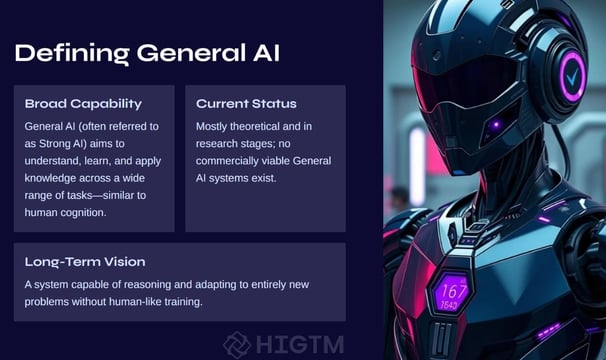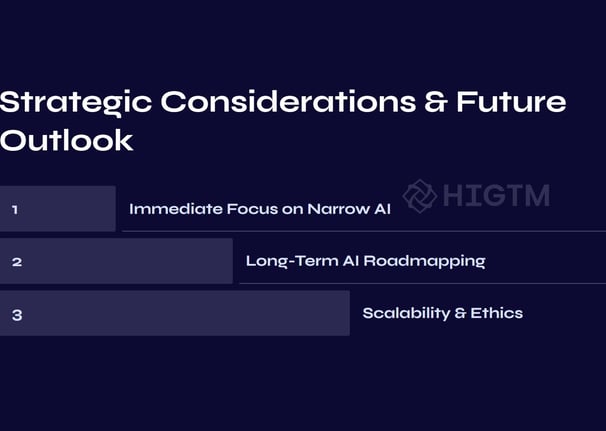5. Types of AI (Narrow vs. General) – Scope for SMEs
The purpose of this post is to unpack the differences between Narrow (Weak) AI—the type of AI that’s already transforming how we work—and the still largely theoretical General (Strong) AI—the more science-fiction-like system that mimics full human cognition. We’ll explore what each entails, clarify how SMEs can take advantage of the current state of AI, and suggest strategic considerations for the future.
Q1: FOUNDATIONS OF AI IN SME MANAGEMENT - CHAPTER 1 (DAYS 1–31): CORE AI CONCEPTS & VALUE PROPOSITION
Gary Stoyanov PhD
1/5/20256 min read

1. Defining Narrow AI
Narrow AI, often called Weak AI, refers to systems designed to perform specific tasks or solve particular problems. These algorithms excel within well-defined parameters, relying on data to provide predictions, classifications, or recommendations. The hallmark of Narrow AI is that it doesn’t aim for a full understanding of the world—just proficiency in a singular function.
1.1 Characteristics of Narrow AI
Task-Centric
Narrow AI isn’t attempting to learn everything. Instead, it zeroes in on a single domain—like detecting credit card fraud, reading medical images, or recommending products to online shoppers.
Data-Driven
Models are trained on relevant historical data. If the data is structured and of good quality, the AI can learn to replicate (or outperform) human judgment in that domain.
Predictive Power
Because Narrow AI learns from real-world examples, it identifies patterns humans might miss—like subtle correlations in sales data or hidden relationships in customer churn.
Limited Adaptability
A chatbot trained to handle banking inquiries can’t suddenly shift to diagnosing mechanical problems in a car. Each function is carefully “tuned” to a specific scope.
1.2 Everyday Examples
Predictive Analytics for Marketing: By analyzing past campaign data, user engagement, and demographics, an AI model can forecast how likely certain customers are to respond to future promotions.
Chatbots for Customer Service: Chatbots or virtual assistants handle routine inquiries—account balances, order tracking—ensuring human reps have more time for complex or high-value tasks.
Recommendation Engines: Popular in e-commerce, these algorithms suggest items based on customer browsing or purchase history, boosting conversion rates and average order values.
Why It Matters for SMEs: Narrow AI is accessible and immediate. Many cloud providers offer pay-as-you-go machine learning services that let you build a predictive model without huge infrastructure costs. By focusing on one or two tasks—say, automating your email support or optimizing inventory—SMEs can see tangible gains in efficiency and ROI.
2. Defining General AI
In contrast, General AI (often termed Strong AI) describes a system with the broad cognitive abilities we associate with human intelligence—understanding, learning, and applying knowledge across vastly different tasks without being specifically programmed for each. This is the type of AI often depicted in science fiction, where a single robot or software agent reasons as adeptly as any person, adapting to unfamiliar problems on the fly.
2.1 Characteristics of General AI
Broad Capability
A true General AI wouldn’t be confined to one domain. It could analyze legal documents, create marketing strategies, solve intricate math problems, or even offer personal counseling—all with human-like proficiency.
Self-Directed Learning
Rather than merely detecting patterns in one dataset, a general AI could continually teach itself new skills and knowledge, akin to human lifelong learning.
Current Status
While research labs explore advanced architectures—like cognitive neural networks or theoretical frameworks—no commercially viable General AI systems exist as of now. Even the most sophisticated language models or robotics programs are still domain-constrained, known as narrow or specialized forms of AI.
Significant Resource & Ethical Challenges
Achieving human-level cognition demands enormous computing power, advanced algorithms, and robust data. Ethical implications around autonomy, accountability, and safety also remain unresolved.
2.2 The Hype vs. Reality
Hollywood and sensational headlines sometimes conflate breakthroughs in Narrow AI with steps toward General AI. True General AI remains largely a future vision—exciting yet unproven. For SMEs concerned about immediate ROI, focusing on the present capabilities of Narrow AI makes more practical sense.
Why It Matters for SMEs: While it’s good to keep an eye on emerging technologies, waiting for General AI to mature could mean missing out on immediate, actionable benefits. General AI is still a research horizon; the solutions that bring tangible value now are grounded in Narrow AI. That’s where SMEs should invest time, talent, and resources.
3. Practical Applications of Narrow AI for SMEs
Since General AI remains theoretical, the real story today is how Narrow AI can transform small and medium-sized enterprises. By targeting everyday challenges—like forecasting demand or personalizing customer interactions—SMEs can implement easily integrated AI modules that produce prompt returns.
3.1 Demand Forecasting
Why It Matters: Demand forecasting affects inventory risk (overstock vs. stockouts), cash flow, and customer satisfaction.
Example: An e-commerce SME using historical sales data and seasonal trends to accurately predict upcoming demand. Coupled with real-time analytics—like site traffic or promotions—it refines these forecasts on the go, minimizing waste and ensuring popular items are always in stock.
Key Benefits:
Reduced holding costs
Greater responsiveness to market shifts
Increased accuracy leading to customer loyalty
3.2 Personalized Marketing
Why It Matters: Relevance is king in customer engagement. With AI, marketing efforts become more targeted and context-aware.
Example: An AI-driven email campaign that segments audiences based on their past purchases, browsing behavior, or demographic details, leading to personalized product recommendations.
Key Benefits:
Higher open and click-through rates
Enhanced customer experience
Data-backed decisions rather than blanket marketing approaches
3.3 Operational Efficiency
Why It Matters: Routine tasks can weigh heavily on SMEs with fewer staff and tighter margins.
Example: Chatbots and NLP-driven ticket-routing systems can handle routine customer queries instantly—like resetting passwords or checking order statuses—freeing staff for more complex interactions. AI also powers automated quality checks in manufacturing or auto-filing in accounting.
Key Benefits:
Reduced bottlenecks, faster turnaround times
Lower human error rates in mundane tasks
Teams focus on innovation, problem-solving, and relationship building
HIGTM Perspective: Focusing on these “quick wins” with specialized, Narrow AI solutions can produce immediate, measurable ROI without overhauling entire workflows. Start with a pilot in one department, validate success metrics, and scale once you see the financial and operational impact.
4. Current State of General AI
While the media might sensationalize each new advanced language model or robotics feat as a leap toward human-like intelligence, experts generally agree that General AI remains a distant goal. Here’s why:
4.1 Ongoing Research in Labs
Leading Tech Labs: Organizations like DeepMind, OpenAI, and major academic institutions are experimenting with architecture designs that push machine learning boundaries.
Breakthroughs & Barriers: Although large language models and advanced reinforcement learning systems keep improving, they each excel at specialized tasks (language generation, game-play strategy, etc.). Achieving broad, human-level cognition is nowhere near commercialization.
4.2 Hype vs. Business Reality
Narrow vs. General: Narrow AI breakthroughs often get hyped in mainstream news as steps toward a “sentient AI.” In practical business contexts, these are specialized solutions with limited scope.
Time Horizons: Realistically, it could be decades before fully general AI is widely available—if it ever becomes feasible.
4.3 Implications for SMEs
Adoption Mindset: SMEs shouldn’t hold off on AI projects, awaiting a “magic bullet” of General AI. The best route is to exploit existing specialized solutions that solve current-day challenges.
Monitoring Developments: Keeping an eye on new research is still wise. Potential game-changers—like advanced AI that can handle broader contexts—could emerge. But serious ROI for smaller businesses lies in the narrow domain solutions available now.
5. Strategic Considerations & Future Outlook
Knowing the difference between Narrow AI and General AI helps SMEs shape their tech investments, training pathways, and innovation roadmaps. Implementing Narrow AI today can yield measurable improvements; staying informed on General AI ensures you’re ready to pivot when new breakthroughs genuinely make sense for your scale.
5.1 Immediate Focus on Narrow AI
Rationale: Quick wins, feasible budgets, and specialized tools map well to SME environments.
Action Steps: Identify your biggest pain points, evaluate available AI solutions, and conduct pilot projects with well-defined KPIs. Examples:
Sales forecasting to reduce inventory misalignments.
Chatbots to handle routine inquiries and cut customer support backlog.
5.2 Long-Term AI Roadmapping
Why: Even though General AI is far off, AI capabilities are evolving at a rapid clip. New frameworks, advanced language models, and integrated analytics platforms keep emerging.
How:
Periodic Re-Evaluation: Every 6–12 months, revisit the AI landscape. Are there new tools or updates that can enhance your existing solutions?
Collaboration & Networking: Consider partnerships with universities or AI research hubs for early insights, or attend relevant conferences to discover emerging trends.
5.3 Scalability & Ethics
As AI expands within any organization, so do data governance and responsible use obligations. Failing to manage data properly or ignoring regulatory standards can undermine your efforts:
Data Governance: Ensure compliance with privacy laws (e.g., GDPR) and maintain transparent data collection and handling processes.
Explainability: If your AI influences critical decisions (e.g., loan approvals, hiring), consider implementing AI that offers interpretable decisions.
Trust & Accountability: Communicate openly about how and why AI is used, helping customers and employees feel secure and informed.
HIGTM Approach: We encourage SMEs to start narrow, measuring success and refining strategies continuously. This agile, incremental approach keeps AI aligned with evolving business objectives. Meanwhile, we advise monitoring AI research developments to stay ahead, but not at the expense of immediate, practical solutions.
6. Key Takeaways & Moving Forward
6.1 Key Takeaways
Narrow AI Is Operational Today
Chatbots, predictive analytics, and recommendation systems are widely accessible. SMEs can start implementing them with minimal capital and see near-term results.
General AI Remains a Research Frontier
Media hype aside, truly generalized, human-like AI doesn’t exist in viable commercial form. Its potential is immense, but practical adoption for SMEs is years—if not decades—away.
Align AI with Real-World Outcomes
Start with clear objectives—cut costs, boost revenue, enhance customer experiences. Because Narrow AI is domain-specific, choose solutions that tackle your biggest challenges.
Stay Ethical & Scalable
As your use of AI grows, so do considerations like data privacy, model governance, and responsible deployment. Integrate these guardrails early.
Continuous Engagement
AI models require monitoring and updates. Keep refining your data pipelines, adjusting hyperparameters, and tracking performance metrics to sustain accuracy and efficiency.
6.2 Looking Ahead
In an environment where every edge counts, SMEs that adopt Narrow AI effectively can streamline operations, offer personalized service, and harness data for smarter decisions—without waiting for the elusive dream of General AI. The path to AI success lies in applying the right tools to specific business goals, maintaining agility, and staying alert to new developments that might expand your capabilities down the road.




Turn AI into ROI — Win Faster with HIGTM.
Consult with us to discuss how to manage and grow your business operations with AI.
© 2025 HIGTM. All rights reserved.
